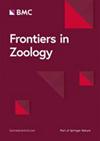Modeling habitat suitability and connectivity for the sole endemic genus of Italian vertebrate: present and future perspectives
IF 2.6
2区 生物学
Q1 ZOOLOGY
引用次数: 0
Abstract
Amphibians are the most globally threatened vertebrates, facing a particularly high risk of extinction in some regions, such as the Mediterranean basin. Within this region, the genus Salamandrina, comprising two species of notable conservation concerns, managed to persist throughout historical climate changes exclusively along the Italian peninsula. Among the main threats to this genus are habitat loss and climate change, as this salamander is adapted to humid forests and relies heavily on water sources, such as small streams, for reproduction. In this study, we employed fine-scale species distribution models (SDMs) to estimate areas projected to remain suitable for Salamandrina species in the future and areas expected to become unsuitable, incorporating bioclimatic, topographic, and habitat variables. We also evaluated landscape connectivity and identified ecological corridors that could facilitate movement through circuit-theory techniques, analyzing potential changes under different scenarios. Additionally, considering known hybridization events in a contact zone between the two species, we measured connectivity to assess whether this process might change in the future. We found several suitable areas that mostly align with the known ranges of both species. Future projections showed an overall decline in habitat suitability, with a northwestern shift. While strong in certain areas, landscape connectivity is expected to decrease overall. Specifically, our results revealed several corridors for S. perspicillata (the northern species), with higher connectivity values in the Central Apennines. For S. terdigitata (the southern species), a crucial corridor in the Catena Costiera Massifs, in the western southernmost region of the Italian peninsula, connects two key conservation areas. In the contact zone, we identified corridors that could favor hybridization between the species, with predictions suggesting an increase. Our findings inform the long-term conservation of a unique salamander genus. Strengthening conservation measures on Salamandrina species in areas predicted to become unsuitable or in areas that could become suitable and serve as ecological corridors will be critical. Furthermore, future monitoring efforts should focus on the corridors identified in the contact zone to assess whether the hybridization process is ongoing and at what rate.意大利脊椎动物唯一特有属的生境适宜性和连通性建模:现在和未来的观点
两栖动物是全球最受威胁的脊椎动物,在地中海盆地等一些地区面临着特别高的灭绝风险。在这个地区,Salamandrina属,包括两个值得关注的保护物种,成功地在意大利半岛的历史气候变化中持续存在。该属面临的主要威胁是栖息地丧失和气候变化,因为这种蝾螈适应潮湿的森林,严重依赖水源,如小溪,进行繁殖。在本研究中,我们采用精细尺度物种分布模型(SDMs),结合生物气候、地形和栖息地变量,预测了未来Salamandrina物种的适宜区和不适宜区。我们还评估了景观连通性,并通过环路理论技术确定了促进运动的生态走廊,分析了不同场景下的潜在变化。此外,考虑到两个物种之间接触区已知的杂交事件,我们测量了连通性,以评估这一过程是否会在未来发生变化。我们找到了几个适合的地区,这些地区与这两个物种的已知范围基本一致。未来的预测显示,栖息地适宜性总体下降,并向西北方向转移。虽然某些地区的景观连通性很强,但预计整体上将下降。具体而言,我们的研究结果显示,在亚平宁山脉中部,北方种的S. perspicillata有多条通道,具有较高的连通性值。对于S. terdigitata(南部物种)来说,在意大利半岛最南端的Catena Costiera山脉,一条重要的走廊连接着两个关键的保护区。在接触区,我们确定了有利于物种间杂交的走廊,预测表明这种走廊会增加。我们的发现为一种独特的蝾螈属的长期保护提供了信息。在预测不适合或可能适合作为生态走廊的地区加强对蝾螈的保护措施将是至关重要的。此外,今后的监测工作应侧重于在接触区确定的走廊,以评估杂交过程是否正在进行以及以何种速度进行。
本文章由计算机程序翻译,如有差异,请以英文原文为准。
求助全文
约1分钟内获得全文
求助全文
来源期刊

Frontiers in Zoology
ZOOLOGY-
CiteScore
4.90
自引率
0.00%
发文量
29
审稿时长
>12 weeks
期刊介绍:
Frontiers in Zoology is an open access, peer-reviewed online journal publishing high quality research articles and reviews on all aspects of animal life.
As a biological discipline, zoology has one of the longest histories. Today it occasionally appears as though, due to the rapid expansion of life sciences, zoology has been replaced by more or less independent sub-disciplines amongst which exchange is often sparse. However, the recent advance of molecular methodology into "classical" fields of biology, and the development of theories that can explain phenomena on different levels of organisation, has led to a re-integration of zoological disciplines promoting a broader than usual approach to zoological questions. Zoology has re-emerged as an integrative discipline encompassing the most diverse aspects of animal life, from the level of the gene to the level of the ecosystem.
Frontiers in Zoology is the first open access journal focusing on zoology as a whole. It aims to represent and re-unite the various disciplines that look at animal life from different perspectives and at providing the basis for a comprehensive understanding of zoological phenomena on all levels of analysis. Frontiers in Zoology provides a unique opportunity to publish high quality research and reviews on zoological issues that will be internationally accessible to any reader at no cost.
The journal was initiated and is supported by the Deutsche Zoologische Gesellschaft, one of the largest national zoological societies with more than a century-long tradition in promoting high-level zoological research.
 求助内容:
求助内容: 应助结果提醒方式:
应助结果提醒方式:


